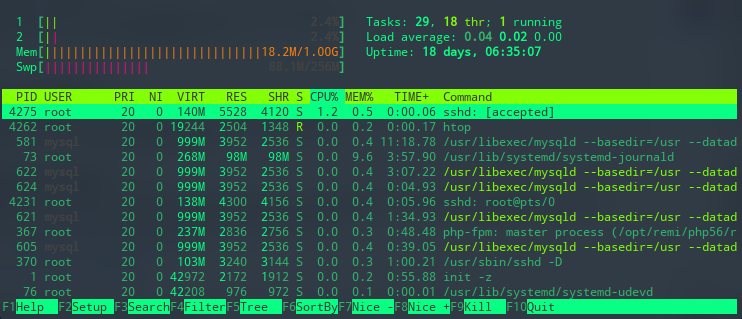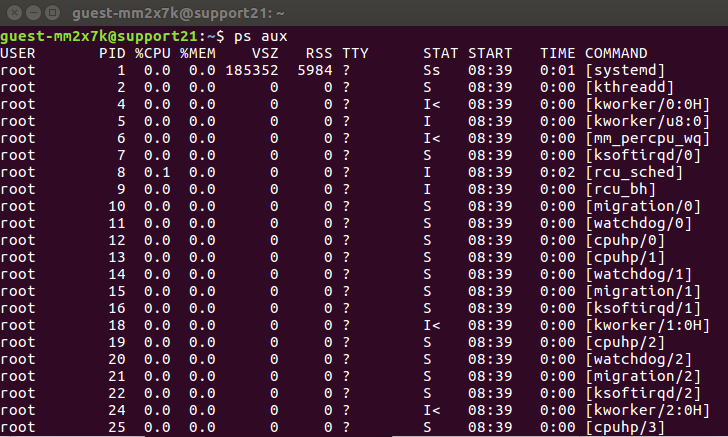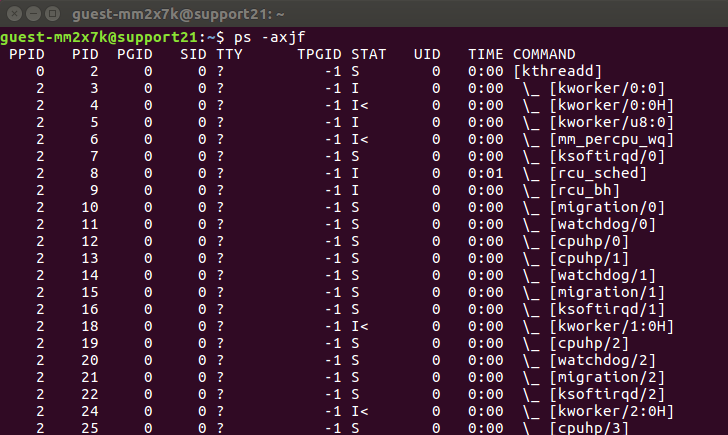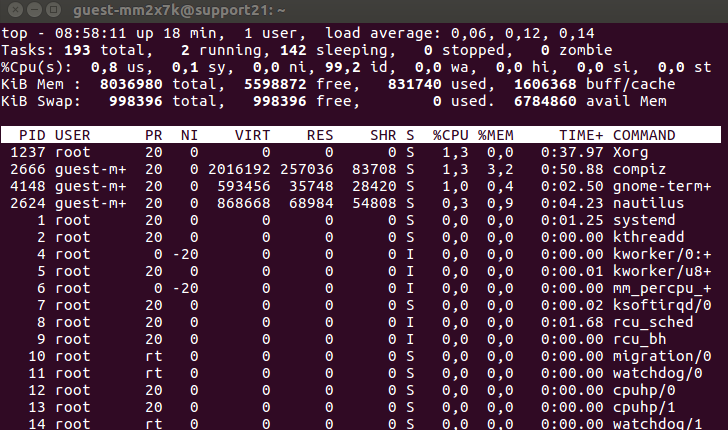- Unix / Linux — Processes Management
- Starting a Process
- Foreground Processes
- Background Processes
- Listing Running Processes
- Stopping Processes
- Parent and Child Processes
- Zombie and Orphan Processes
- Daemon Processes
- The top Command
- Job ID Versus Process ID
- How to List Running Processes in Linux: A Beginner’s Guide
- Introduction to Linux Processes
- How to List Running Processes in Linux?
- Utilizing the “ps” Command
- Using the “top” Command
- Running “htop” Command
- Conclusion
Unix / Linux — Processes Management
In this chapter, we will discuss in detail about process management in Unix. When you execute a program on your Unix system, the system creates a special environment for that program. This environment contains everything needed for the system to run the program as if no other program were running on the system.
Whenever you issue a command in Unix, it creates, or starts, a new process. When you tried out the ls command to list the directory contents, you started a process. A process, in simple terms, is an instance of a running program.
The operating system tracks processes through a five-digit ID number known as the pid or the process ID. Each process in the system has a unique pid.
Pids eventually repeat because all the possible numbers are used up and the next pid rolls or starts over. At any point of time, no two processes with the same pid exist in the system because it is the pid that Unix uses to track each process.
Starting a Process
When you start a process (run a command), there are two ways you can run it −
- Foreground Processes
- Background Processes
Foreground Processes
By default, every process that you start runs in the foreground. It gets its input from the keyboard and sends its output to the screen.
You can see this happen with the ls command. If you wish to list all the files in your current directory, you can use the following command −
This would display all the files, the names of which start with ch and end with .doc −
The process runs in the foreground, the output is directed to my screen, and if the ls command wants any input (which it does not), it waits for it from the keyboard.
While a program is running in the foreground and is time-consuming, no other commands can be run (start any other processes) because the prompt would not be available until the program finishes processing and comes out.
Background Processes
A background process runs without being connected to your keyboard. If the background process requires any keyboard input, it waits.
The advantage of running a process in the background is that you can run other commands; you do not have to wait until it completes to start another!
The simplest way to start a background process is to add an ampersand (&) at the end of the command.
This displays all those files the names of which start with ch and end with .doc −
Here, if the ls command wants any input (which it does not), it goes into a stop state until we move it into the foreground and give it the data from the keyboard.
That first line contains information about the background process — the job number and the process ID. You need to know the job number to manipulate it between the background and the foreground.
Press the Enter key and you will see the following −
The first line tells you that the ls command background process finishes successfully. The second is a prompt for another command.
Listing Running Processes
It is easy to see your own processes by running the ps (process status) command as follows −
One of the most commonly used flags for ps is the -f ( f for full) option, which provides more information as shown in the following example −
Here is the description of all the fields displayed by ps -f command −
| Sr.No. | Column & Description | ||||||||||||||||||||||||||||||||||||||||||
|---|---|---|---|---|---|---|---|---|---|---|---|---|---|---|---|---|---|---|---|---|---|---|---|---|---|---|---|---|---|---|---|---|---|---|---|---|---|---|---|---|---|---|---|
| 1 |
| Sr.No. | Option & Description | |||||||||||||||||||||||||||||||||||||||
|---|---|---|---|---|---|---|---|---|---|---|---|---|---|---|---|---|---|---|---|---|---|---|---|---|---|---|---|---|---|---|---|---|---|---|---|---|---|---|---|---|
| 1 |
| Keys | Functions |
| k | Kills a process |
| M | Sorts the list by memory usage. |
| N | Sorts the list by PID. |
| r | Changes the priority of a process. |
| h | Displays the help window. |
| z | Displays running processes in colors. |
| d | Changes the refresh time interval. |
| c | Displays the absolute path of a process. |
| CTRL+C or q | Stops the top command. |
Keep in mind that the keys above are case sensitive, so be sure not to enable the caps lock.
Running “htop” Command
Both the htop and top command display the same information when listing your Linux processes, but the former offers user-friendly features that are great for everyday process management.
First thing first, the htop command allows you to scroll vertically and horizontally. As such, you can see the complete list of your Linux processes along with their full command lines.
What’s more, the command allows you to use a mouse to select items, kill processes without inserting their PIDs, change the priority of multiple processes easily, and so on.
Unfortunately, most Linux distributions don’t have this command right out of the box, so you need to install it manually.
If you use Ubuntu, you can install htop by running the following command:
Once installed, type htop, and you’ll get a list of all your Linux processes. 
| Keys | Functions |
| F9 | To kill a process. |
| F8 | Increase the priority of a process. |
| F7 | Decrease the priority of a process. |
| F6 | Sort processes by any column. |
| F5 | Display processes in a tree view. |
| F4 | Filter the processes by name. |
| F3 | Search for a process. |
| F2 | Open htop setup. |
| F1 | Display the help menu. |
Conclusion
It is important to know how to list all running processes in your Linux operating system. The knowledge will be useful when you need to manage processes.
Let’s take a look once more at the three commands that you can use to list Linux processes:
- ps command — outputs a static view of all processes.
- top command — displays the real-time list of all running processes.
- htop command — shows the real-time result and is equipped with user-friendly features.
Which command do you prefer? Share your thoughts in the comment section below!
Domantas leads the content and SEO teams forward with fresh ideas and out of the box approaches. Armed with extensive SEO and marketing knowledge, he aims to spread the word of Hostinger to every corner of the world. During his free time, Domantas likes to hone his web development skills and travel to exotic places.
Источник

 You can use ps aux to get more in-depth information about your running processes. Here’s a breakdown of each argument:
You can use ps aux to get more in-depth information about your running processes. Here’s a breakdown of each argument: If you want to list Linux processes in a hierarchical view, use the ps -axjf command. In this format, the shell will put child processes under their parent processes.
If you want to list Linux processes in a hierarchical view, use the ps -axjf command. In this format, the shell will put child processes under their parent processes.  Aside from those two options, here are some other common examples of the ps command that list running processes in Linux:
Aside from those two options, here are some other common examples of the ps command that list running processes in Linux: Once the shell returns the list, you can press the following keys to interact with it:
Once the shell returns the list, you can press the following keys to interact with it:


